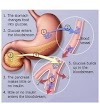In addition to their use as food and spice, chilies or red pepper have been popular in both Ayurvedic and homeopathic treatments since ancient times. Red pepper is used as a natural fat burner and painkiller, to treat ulcers, increase metabolism, improve circulation, boost the immune system and aid digestion. It is used as a tonic for the heart, kidneys, lungs, pancreas, spleen, and stomach and to treat herpes, shingles, and rheumatism. It is also known to combat chills, treat psoriasis and indicated for preventing heart disease.
Red pepper has many common names such as African pepper, Bird pepper, Chili pepper, Tabasco Pepper and Zanzibar Pepper. The powerful compound in it called capsaicin is what gives red pepper its hotness and is also responsible for most of its beneficial effects on human physiology. The hotter the pepper, the higher its content of capsaicin
All the parts of the plant, including the roots, leaves, and fruits, have different uses. In African communities, its leaves are boiled with palm kernel oil as a laxative for pregnant women. The infusion of the leaf is used as a remedy for stomach pains, anasarca (a form of dropsy) and ascites in adults. A decoction of the root in local dry gin {alcohol} is used against inflammatory tumors and rheumatism. The fruit is a crush, mixed with oil and apply to the area affected by arthritis and rheumatism.
A study found that Capsicum, the peppery ingredient in red pepper help alleviate fatigue in people with acute tonsillitis.
In experts assessed the efficacy of a fixed-combination herbal compound of Phytolacca americana, commonly referred to as pigeon berry; Guajacum sanctum commonly referred to as tree-of –life; and Capsicum present in red pepper in treating acute tonsillitis in the 2000 edition of Journal Advances in Therapy.





0 Comments